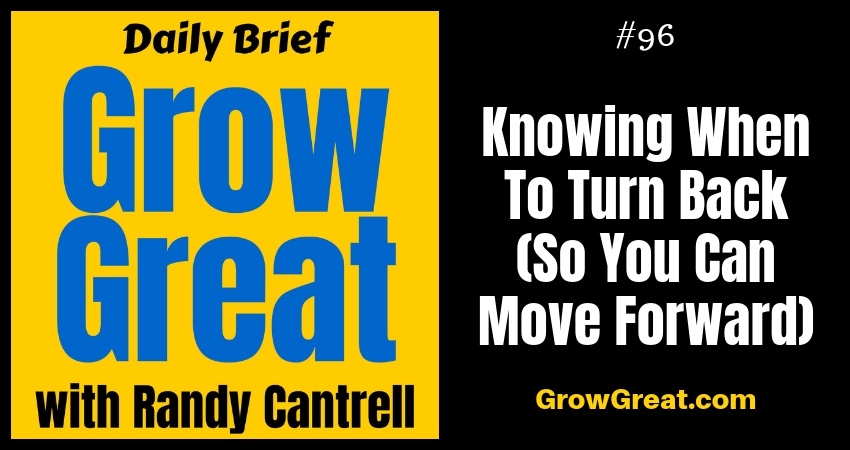Pouring Emotion Into And Out Of Your Business – Grow Great Daily Brief #101 – November 9, 2018
Podcast: Play in new window | Download (Duration: 10:39 — 10.9MB)
Subscribe: Apple Podcasts | Spotify | Email | RSS | More
We have hot buttons. All of us. Things we’re just overly zealous about. For some reason that maybe we don’t even know.
Some business owners are fanatical about employee honesty. They’re paranoid that people are always stealing. They lead and manage based on that assumption.
Some are fanatical about inventory refusing to discount it quickly enough because they over-value it. It impacts how they manage and lead.
Emotions are the bad guy. We all have them and without them, we’re not fully human. Psychopaths don’t display emotions quite like most of us. That’s an extremely negative example. Sociopaths can display extreme emotions. That’s another negative example.
Emotions fuel us. When we have our emotions in sync with reality it’s a great thing. But when our emotions overrun reality and logic, we can encounter problems.
This week a friend and I were talking about some business opportunities and he told me a story. Two people went into business together with very different skills and responsibilities. They appropriately notated what each of them would do, then set about to do it. Less than a year later they were experiencing solid success, but one of the partners began to feel her contributions were worth more than her partner’s. Resentment was setting in. It was an unrealistic emotion. She wasn’t seeing things for what they really were. The truth was, her partner was handling a ton of things that were enabling her to do what she was best at. Without the partner’s contribution, there’s no way the enterprise would have been as successful.
We’ve all got stories of unreasonable behavior in the face of strong evidence. Proof that emotions need some type of regulation.
An entrepreneur is angry with an employee who gave a customer a discount of less than $100 without getting permission first. He goes OFF on the employee and the rest of the staff to make a point. For hours he spends time trying to figure out ways to prevent this from ever happening again. Less than $100 wrecks the entire company for the day. And the owner continues to obsess about a “lack of control.” So it goes when emotions rule the day.
But…
Emotions play a vital role in the establishment and building of our companies. We’re driven to accomplish something. It’s not always rational. The vast majority of small business owners earn less money than they could make working as an employee for somebody else. But they don’t want to work for somebody else. People have feelings, emotions, and desires that may be uniquely their own. Who are we to judge?
A software developer earning good money wants to open up a cookie shop.
A lawyer wants to start a charter fishing company in the Gulf of Mexico.
A physician wants to renovate an old house and create a bed ‘n breakfast.
Go figure. May not make sense to us, but it makes all the sense in the world to them.
Those emotions are tied to doing work that’s more rewarding than the work they’re currently doing. They don’t care about the money earning comparisons. They’re willing to earn fewer dollars so they can achieve something else. Something that matters more to them. It’s largely an emotional decision.
Your enthusiasm and passion aren’t fueled so much by logic, but whatever logical foundation exists is fueled by emotions. I could likely bring up a topic close to your heart and your interest in that topic would be noticeable. Your voice would change. The tempo of your speech would amp up. Your eyes would widen. You’d lean more forward. Emotions.
Those are positive. Well, they could be if they’re leveraged properly. Context matters. The software developer with 3 kids and a wife earning $120K a year may want to open up a cookie shop and risk the entire family’s savings. Maybe a good idea. Maybe not. He and his family can judge. Emotions.
A business owner can obsess about not paying employees more than minimum wage. Emotions. Refusing to budge he finds himself in constant turmoil unable to find or keep competent help. But he won’t budge on the hourly pay rate because he remembers how little money he earned starting out.
One thing has nothing to do with the other. He’s being irrational. It’s purely emotional. And it’ll kill his business.
It happens all the time. Business owners get fixated on something that is a pet peeve – either for or against. And like a dog with a bone, they refuse to let go. They’ve poured so much emotion into their viewpoint they’re unwilling and unable to let go. They need to pour that emotion out of their business so they can grow as leaders/owners and so their business can grow. I see it get in the way often as you peel back why an owner feels the way he does about certain things. When you can finally to the root of the emotion, it hardly ever has one thing to do with the issue at hand. That’s crippling!
It sounds nuts perhaps, but it’s time to take an inventory of your emotions. Time to figure out the ones that serve you well and the ones that stifle your progress. We all have our share of both. This may be best done with a one-word question, “Why?”
Why are you feeling this way? Why does this amp you up so? Why does this bother you?
Why does the software engineer want to open up a cookie shop? He may not even know or understand why. It may be less about a cookie shop and more about his hatred for his boss. He may love engineering software, but he hates doing it for this guy. Or, he may hate engineering software, but he stays because he loves his boss. Or, he may hate all of it and simply love baking cookies. That’s the ball of yarn he’ll have to untangle to better understand why he wants to open a cookie shop.
A feeling can be diffcult to harness. Harder still to let it go if it’s harmful to us. I talk quite about bit about forgiveness and bitterness because I see them destroy a lot of people. When people ask me, “How can I forgive?” — I always offer the same answer. “Just make up your mind.” I’m not being snarky or sarcastic. I mean it. It’s the only way to do it. Just decide. But a mind has to be in a place – a place where a person is ready to make that decision. Else, it won’t happen.
Ditto with any other negative emotion that’s crippling your business or your organization. Throw a fit when an employee offers a discount of $85 without asking you. Make a full day production out of it if you want. Show everybody who’s boss and how intolerant you’re going to be that behavior. You’ll wreck way more than a day. You’ll wreck your company. All for $85?
Come to yourself. Realize the risk and reward of the emotion. You may feel better after ranting and railing about the $85 discount. But unless you’re an idiot you’ll realize $85 isn’t risking your company, but you going off incessantly about it may. Let reality hit you square in the face so you can see things for what they are — damaging. Then, let go. Pour that emotion down the drain so it ceases being toxic to you and your company.
Replace it with the passion that drives you to higher achievement. Those competitive juices that fuel you to be the best. To deliver superior customer experiences. To do all the things required of becoming “world-class.” You need those emotions. But they’re too often suppressed by the fixation on the $85 unauthorized discount.
It’s good to get worked up. Just make sure you’re getting worked up about the things that will help you and your company grow, improve and transform. I want you and your company to grow great. Don’t let unhinged negative emotions ruin that for you.
Be well. Do good. Grow great!

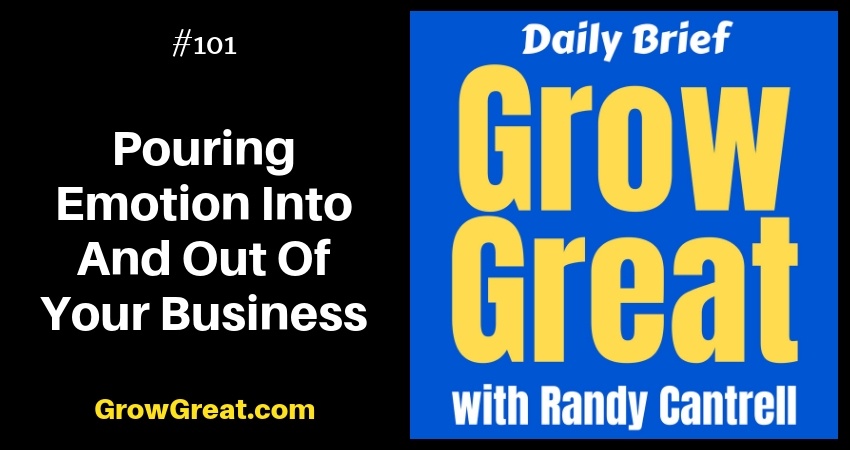

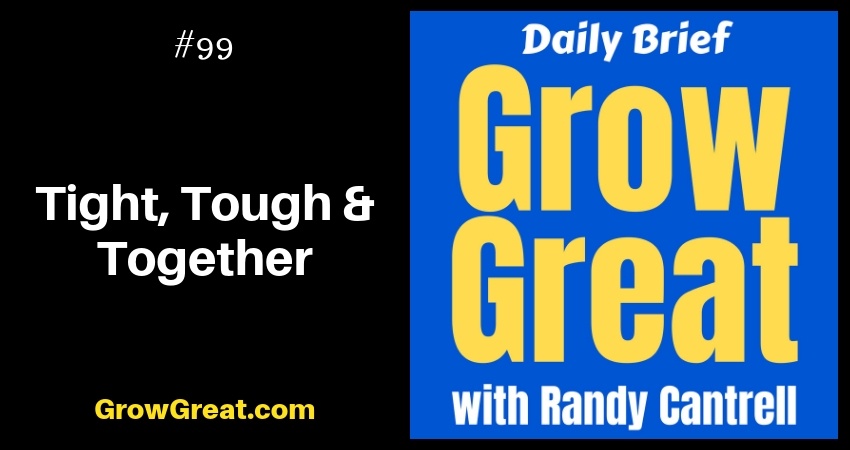



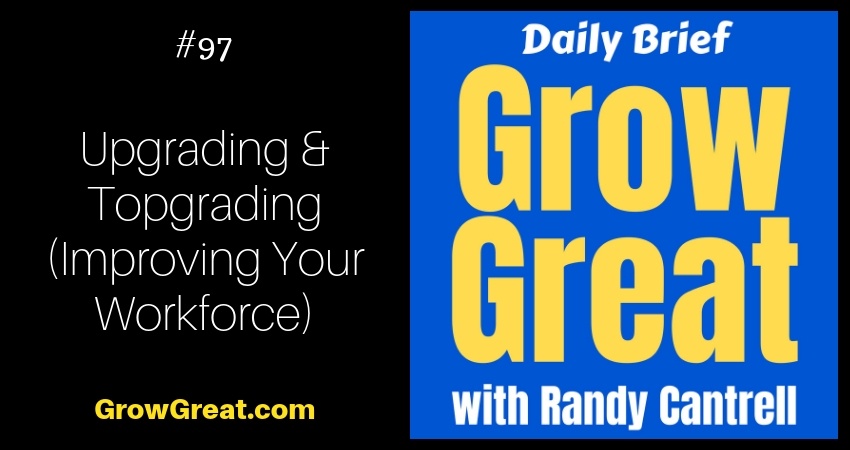
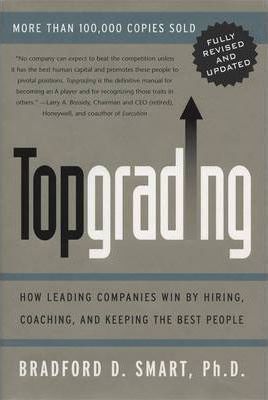 Across all sectors, it seems people are challenged to upgrade, or topgrade their workforce. “Topgrading: How Leading Companies Win by Hiring, Coaching and Keeping the Best People” by Bradford D. Smart was a book published in 1999. It spoke of the need to have superior people if you’re going to build a superior company. Mr. Smart’s advice – and his company – focus on being able to assess people so you can acquire top level talent.
Across all sectors, it seems people are challenged to upgrade, or topgrade their workforce. “Topgrading: How Leading Companies Win by Hiring, Coaching and Keeping the Best People” by Bradford D. Smart was a book published in 1999. It spoke of the need to have superior people if you’re going to build a superior company. Mr. Smart’s advice – and his company – focus on being able to assess people so you can acquire top level talent.